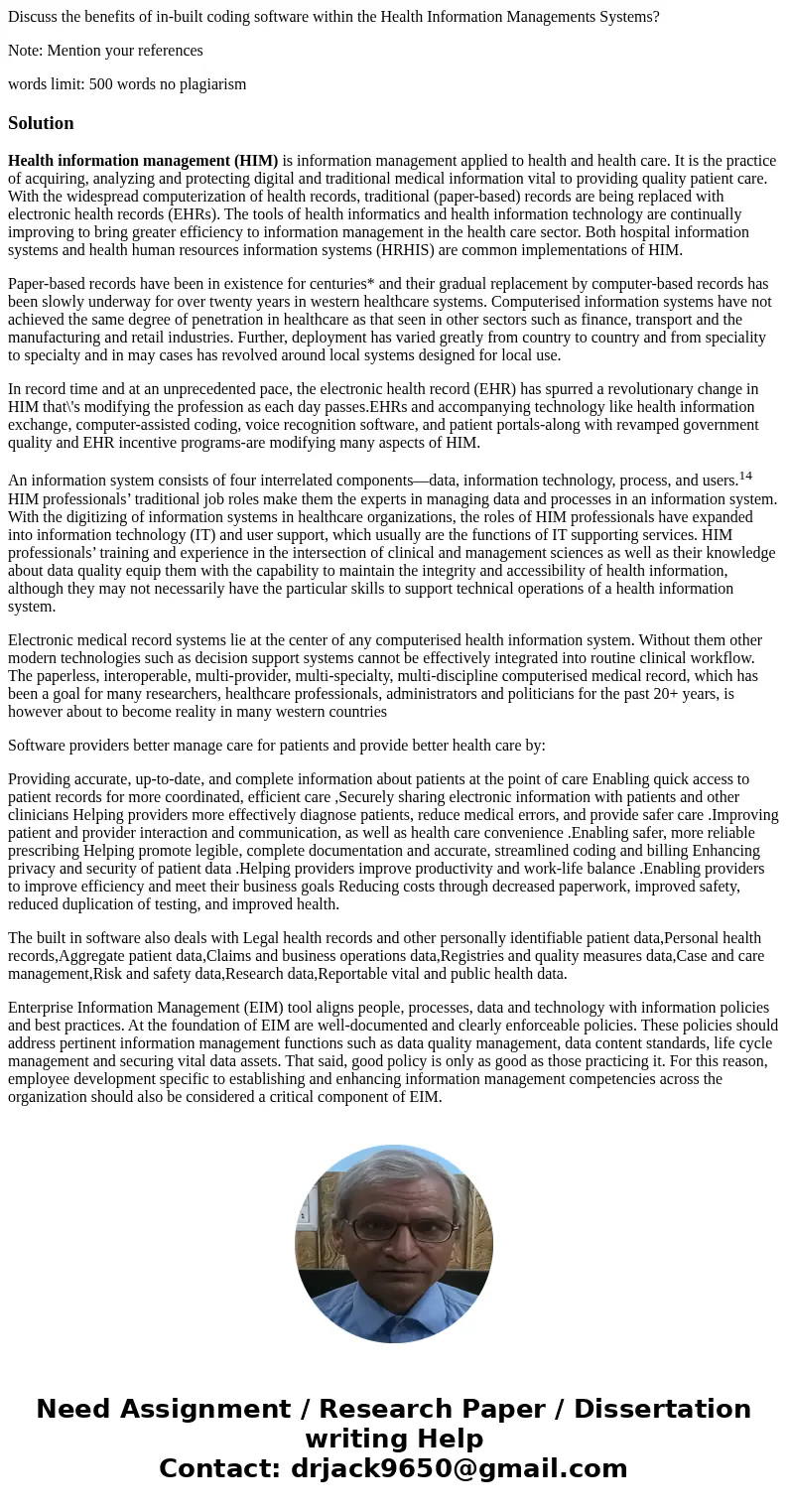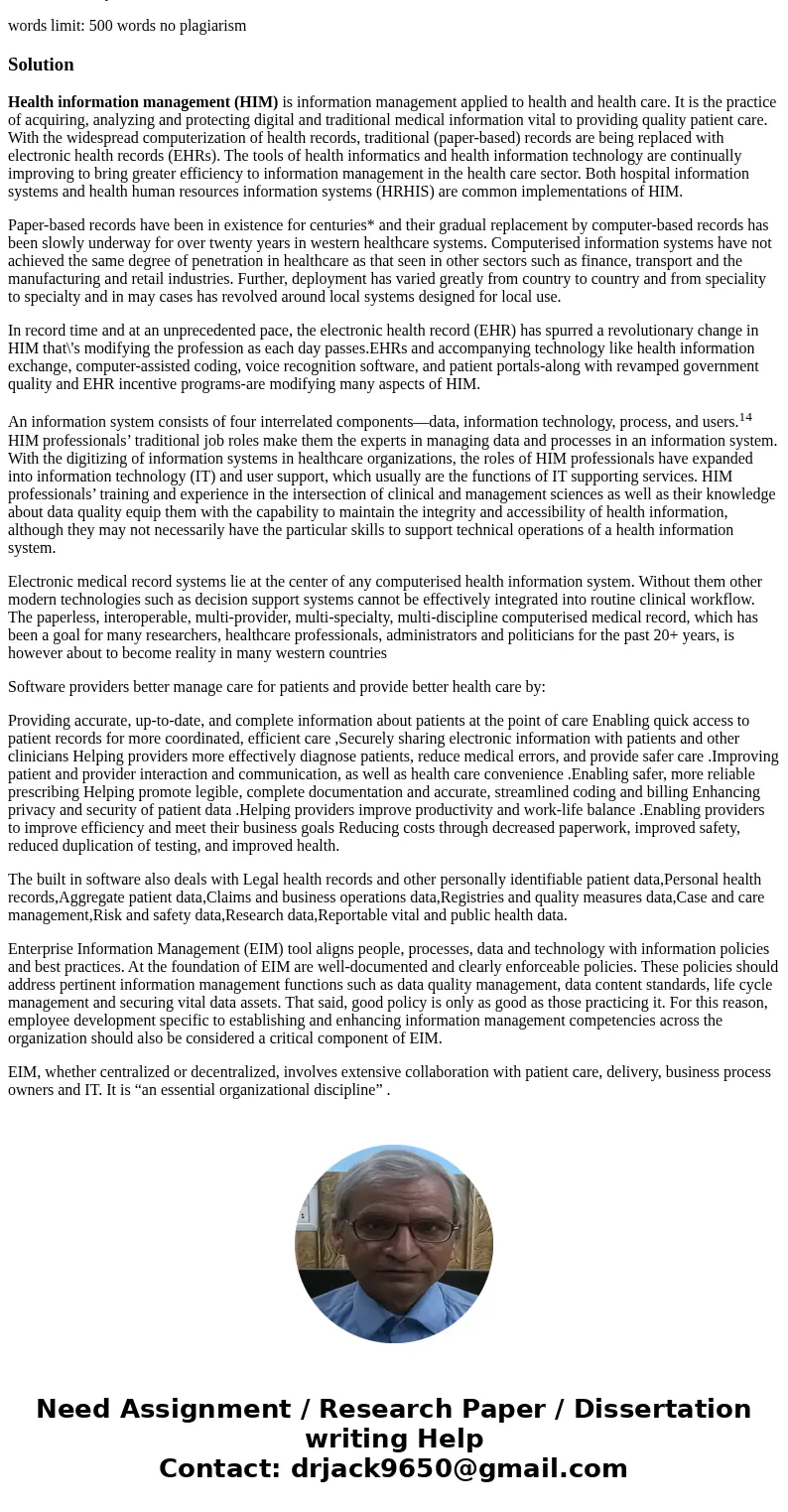Discuss the benefits of inbuilt coding software within the H
Discuss the benefits of in-built coding software within the Health Information Managements Systems?
Note: Mention your references
words limit: 500 words no plagiarism
Solution
Health information management (HIM) is information management applied to health and health care. It is the practice of acquiring, analyzing and protecting digital and traditional medical information vital to providing quality patient care. With the widespread computerization of health records, traditional (paper-based) records are being replaced with electronic health records (EHRs). The tools of health informatics and health information technology are continually improving to bring greater efficiency to information management in the health care sector. Both hospital information systems and health human resources information systems (HRHIS) are common implementations of HIM.
Paper-based records have been in existence for centuries* and their gradual replacement by computer-based records has been slowly underway for over twenty years in western healthcare systems. Computerised information systems have not achieved the same degree of penetration in healthcare as that seen in other sectors such as finance, transport and the manufacturing and retail industries. Further, deployment has varied greatly from country to country and from speciality to specialty and in may cases has revolved around local systems designed for local use.
In record time and at an unprecedented pace, the electronic health record (EHR) has spurred a revolutionary change in HIM that\'s modifying the profession as each day passes.EHRs and accompanying technology like health information exchange, computer-assisted coding, voice recognition software, and patient portals-along with revamped government quality and EHR incentive programs-are modifying many aspects of HIM.
An information system consists of four interrelated components—data, information technology, process, and users.14 HIM professionals’ traditional job roles make them the experts in managing data and processes in an information system. With the digitizing of information systems in healthcare organizations, the roles of HIM professionals have expanded into information technology (IT) and user support, which usually are the functions of IT supporting services. HIM professionals’ training and experience in the intersection of clinical and management sciences as well as their knowledge about data quality equip them with the capability to maintain the integrity and accessibility of health information, although they may not necessarily have the particular skills to support technical operations of a health information system.
Electronic medical record systems lie at the center of any computerised health information system. Without them other modern technologies such as decision support systems cannot be effectively integrated into routine clinical workflow. The paperless, interoperable, multi-provider, multi-specialty, multi-discipline computerised medical record, which has been a goal for many researchers, healthcare professionals, administrators and politicians for the past 20+ years, is however about to become reality in many western countries
Software providers better manage care for patients and provide better health care by:
Providing accurate, up-to-date, and complete information about patients at the point of care Enabling quick access to patient records for more coordinated, efficient care ,Securely sharing electronic information with patients and other clinicians Helping providers more effectively diagnose patients, reduce medical errors, and provide safer care .Improving patient and provider interaction and communication, as well as health care convenience .Enabling safer, more reliable prescribing Helping promote legible, complete documentation and accurate, streamlined coding and billing Enhancing privacy and security of patient data .Helping providers improve productivity and work-life balance .Enabling providers to improve efficiency and meet their business goals Reducing costs through decreased paperwork, improved safety, reduced duplication of testing, and improved health.
The built in software also deals with Legal health records and other personally identifiable patient data,Personal health records,Aggregate patient data,Claims and business operations data,Registries and quality measures data,Case and care management,Risk and safety data,Research data,Reportable vital and public health data.
Enterprise Information Management (EIM) tool aligns people, processes, data and technology with information policies and best practices. At the foundation of EIM are well-documented and clearly enforceable policies. These policies should address pertinent information management functions such as data quality management, data content standards, life cycle management and securing vital data assets. That said, good policy is only as good as those practicing it. For this reason, employee development specific to establishing and enhancing information management competencies across the organization should also be considered a critical component of EIM.
EIM, whether centralized or decentralized, involves extensive collaboration with patient care, delivery, business process owners and IT. It is “an essential organizational discipline” .


 Homework Sourse
Homework Sourse